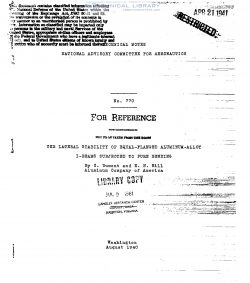naca-tn-770
- Version
- 64 Downloads
- 1.01 MB File Size
- 1 File Count
- November 30, 2016 Create Date
- November 30, 2016 Last Updated
National Advisory Committee for Aeronautics, Technical Notes - The Lateral Stability of Equal Flanged Aluminum Alloy - I - Beams Subjected to Pure Bending

Equal—flanged beams of a special extruded l—section -
'of 278T aluminum alloy were tested in pure-bending, Com—
plete end fixity was not attained. Loading was continued
until a definite maximum value had been reached. Tensile
tests were made on specimens cut from the flanges and the
web of each beam. Compressive stress—strain charaatsrrss’
tics were determined by pack compression tests on sssaig .
name out from the flanges.
Values computed from an equation previously gaggested
by one of the authors for the critical stress at which
such beams become unstable were found to be in good agree-
ment with values computed from experimentally determined
critical bending moments.
Under certain conditions of loading and restraint.
sidewise buckling of beams occurs in much the same way
that column-failures occur in members subjected to direct
compression. The problem of lateral'instability QPJI‘
beans having flanges of equal width has been solved by
Dr. Timoshenko. who has derived (references 1 and 2) cf:
pressions for the critical bending moment for various con—
ditions of loading and restraint. Tiuoshenko's genera:;::
solution of lateral buckling of I‘beaus has been extended
to cover bubkling at stresses beyond'the elastic range and—
the solution has been simplified and presented in such a
form as can-be easily applied by the designing engineers
(See reference 3.) Many tests have been made in tiiaitrr‘
beams failed by lateral buckling. In most of these tests,
however,_exact conditions of restraint were not known and.
consequently, no satisfactory correlation Could be'obtaifiéd
between the test results and theoretical solutions.
In a previous report (reference_é).the results of
tests to study the lateral instability bf unequal—flanged
I—beams, such as used in deck—house construction, were
presented. The results of these tests were in fair_agree—
ment with the theoretical results for fixed—end beams, but
there was some evidence that under the test conditions the
ends of the beams were'something less than completely
fixed. Furthermore. because of the unequal-flange widths
it was impossible to make a satisfactory study of the lat~
eral buckling in the plastic range and because of this, it
was decided to make similar tests using a somewhat lighter
equal~flanged I—section. It-was believed that a greater
degree of end fixity could be achieved with these lighter'
sections and, furthermore. that in those cases in which
buckling occurred above the proportional limit of the ma—
terial, it would be possible to evaluate the effective
reduced modulus.
| File | Action |
|---|---|
| naca-tn-770 The Lateral Stability of Equal Flanged Aluminum Alloy - I - Beams Subjected to Pure Bending.pdf | Download |

Comment On This Post